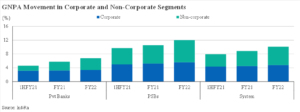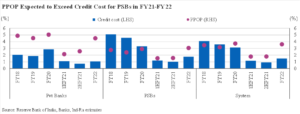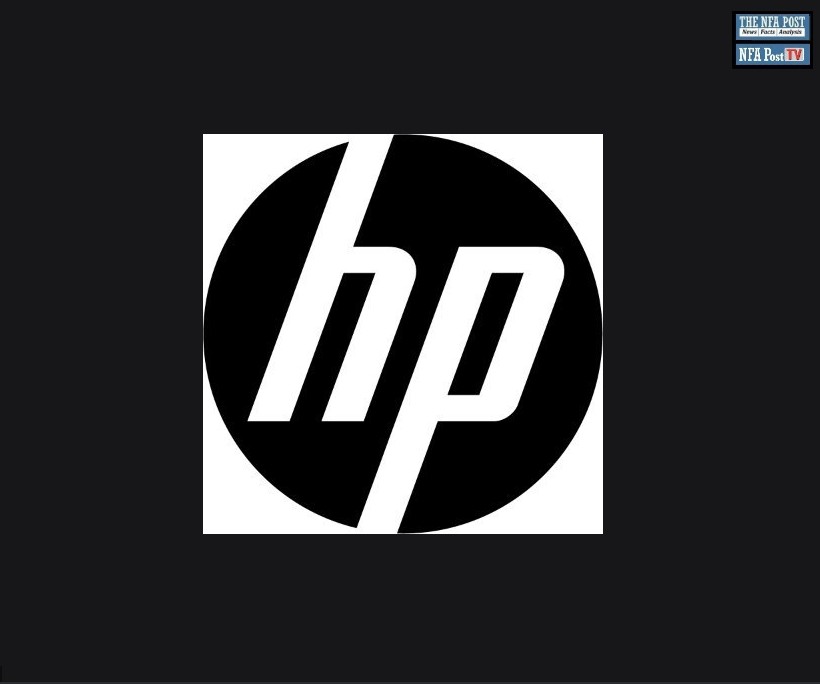Private Banks continue to gain market share both in assets and liabilities, while competing intensely with PSBs. Most have strengthened their capital buffers and proactively managed their portfolio, says India Ratings and Research (Ind-Ra).
The credit rating agency said as growth revives, large Private Banks would benefit from credit migration due to their superior product and service proposition.
Banking sector looks stable
Ind-Ra has revised its outlook on the overall banking sector to stable for FY22 from negative. This is because substantial systemic measures have reduced the system-wide COVID-19 linked stress below the expected levels. Banks have also strengthened their financials by raising capital and building provision buffers.
Ind-Ra has upgraded its FY21 credit growth estimates to 6.9% from 1.8% and 8.9% in FY22, with the improvement in the economic environment in 2HFY21 and the government of India’s (GoI) focus on higher spending especially on infrastructure.
The agency estimates GNPA at 8.8% in FY21 (FY22: 10.1%) and stressed assets at 10.9% (11.7%). Provisioning cost has fallen from its earlier estimate of 2.3% for FY21 to 2.1% (including COVID-19 linked provisions) and is estimated at 1.5% for FY22.
The regulatory changes led to an improvement in public sector banks’ (PSBs) ability to raise AT I capital, a high provision cover on legacy NPAs, overall systemic support resulting in lower-than-expected COVID-19 stress, and minimal surprises arising out of amalgamation of PSBs.
Also, the fact that the GoI has earmarked Rs 34,500 crore for infusion in PSBs in 4QFY21-FY22 should suffice for their near-term growth needs, the agency said.
Stressed Assets to Rise 30% in 2HFY21 and 8% in FY22: Ind-Ra estimates that about 1.24% of the total bank book is under incremental proforma NPA and about 1.75% of the total book could be restructured by end-FY21.
As a conservative measure, the agency has not adjusted for overlaps between those categories. This is the incremental stress purely on account of the COVID-19 pandemic and does not include the slippages that banks would witness in the normal course of business.
Ind-Ra estimates that overall stressed assets (GNPA + restructured) could increase 30% for the banking system, the increase is almost 1.7x in the retail segment in 2HFY21. The stock of stressed retail assets for PSBs could increase to 2.9% in FY22 from 2.1% in FY21, while it could increase from 1.2% to 4.3% for Private Banks.

Comfortable Provision Cover: COVID Linked Provisions add to Buffers: Excluding COVID-19 linked stress, Ind-Ra expects the provision coverage ratio (excluding technical write-offs) for both PSBs and Private Banks to reach 75%-80% by end-FY21.

Legacy Stress Corporate Assets at 3.5% of Gross Bank Credit: Through a bottom-up analysis of stressed corporates using two filters: revenue above Rs 100 crore and interest coverage below 1.5x, Ind-Ra has assessed that stressed corporate assets as a percentage of gross bank credit declined to 15.3% at end-1HFY21 from 15.7% at end-FY20 (FY19: 17.2%, 1HFY19: 19.3%, FY18: 20.2%).
The key reasons for the reduction are low slippages (standstill classification, moratorium etc), write-offs of 0.9%, and no advances growth in 1HFY21. Of this, 3.5% of total bank assets would be stressed (without any external support) and would be the source of slippages in the medium term. This would also have overlaps with restructured assets and / or proforma slippages, it pointed out.
MSME Stress Supported by ECLGS-driven Liquidity: Under the Emergency Credit Line Guarantee Scheme, the GoI provided a guarantee to banks and non-banking financial companies (total guarantee corpus at Rs 3 lakh crore) for extending funds to stressed micro, small and medium enterprises. Based on the progress seen till 25 January 2021, the funds sanctioned by banks under the scheme totalled to Rs 1.98 lakh crore.
Pandemic-driven Elevated Level of Delinquencies in Retail Loans: Banks have also reported a significant amount of restructuring of retail loans along with slippages into proforma gross NPA in 9MFY21. While Private Banks have been more adept at underwriting risk in the segment, they also have a higher share of unsecured retail assets where the borrowers have faced a disproportionate impact on their ability to service loans. PSBs with their exposure to government and public sector employees along with a lower share of unsecured assets have been impacted to a lesser degree than Private Banks.
Deposit Growth Continues Even with Lowest-ever Term Deposit Rates: Bank deposit rates have been the lowest ever in the last 10 years; but the system still saw an 11% yoy higher deposit growth rate at end-December 2020. A surprising fact is that large Private Banks’ deposit rates are even lower than State Bank of India’s (IND AAA/Stable).
As the economic cycle revives, Ind-Ra expects the deposit rates to rise as credit growth revives as well as capital market flows are enhanced. Large banks will be able to attract better rated customers by taking advantage of their lower cost of deposits. Thus, in the agency’s opinion, it will be challenging for mid or small-sized bank to have an asset profile similar to a large bank, Ind-Ra concluded.





